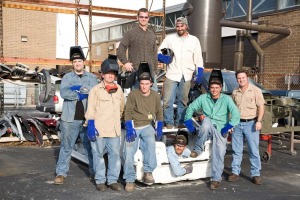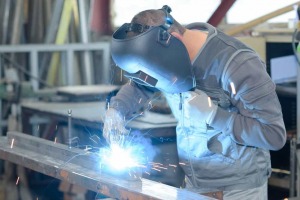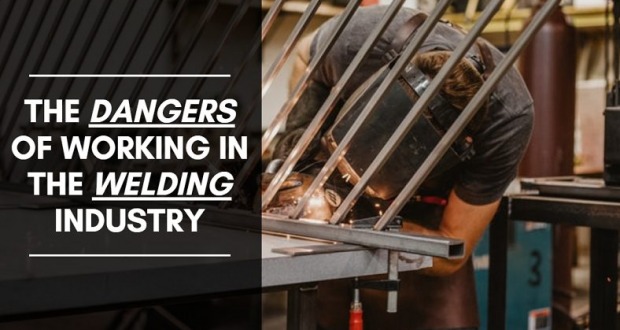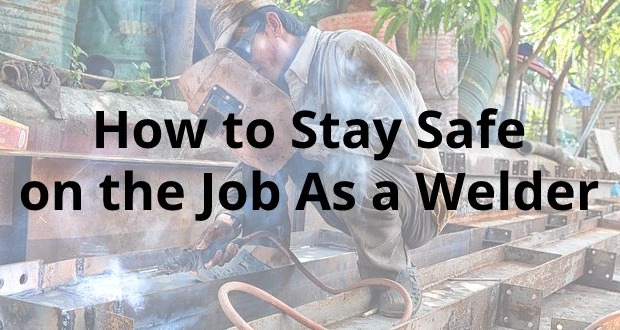Like many professions, welding requires a certain skill in order for it to become the foundation of a career. Unlike many professions, there is no need for a specific educational requirement to begin that training. Most welders can enter an apprenticeship or certification program with a high school diploma, GED, and sometimes without even that level of education.
This does not mean that it is possible to become a welder overnight. It requires plenty of time, work, and dedication. You must be willing to continuously grow your knowledge base so that you can begin to master the skills that do provide a foundation for a new career.
Here is the process that you’ll need to follow and what your income potential will be once you have developed a well-rounded skillset.
There Are 6 Basic Steps to Follow to Become a Welder
Anyone can become a welder. Let’s get that straight from the very beginning. You’ll often find advice floating around the internet that says you need a certain talent or a specific certification so that you can work as a welder. This is not true.
You can become a professional welder through a rigorous training and certification program. All you need to have is a willingness to work, be able to effectively use your hands, and have the funds, either privately or through loans, to purchase the equipment you may need in addition to the tuition you may need to pay.
In some jurisdictions, it is even easier. All you may need to do is wait for an apprenticeship opening with your local welder’s union and be accepted into it. You’ll likely need to pay for your equipment in this scenario, but you could save thousands of dollars by avoiding skill development and certification classes.
Here are the 6 basic steps that you’ll need to follow when you want to become a professional welder:
#1. Make sure you know what welding is all about. Welding can be a very demanding profession. It has specific safety equipment that you’ll need to wear at all times when working to protect yourself. You’ll want to know what the typical day of a welder is like to make sure that it is something you would enjoy. Some may even wish to speak with their physician to see if they can even perform welding work if there are medical conditions that need to be evaluated.
#2. Get the experience needed. Welding is a skill-based profession. Although anyone can pick up a welder and get to work, there is a difference between a good welder and a professional welder. To get the experience you need, it may be necessary to enroll at a local community college or certification center so you can see if welding is something that you’d like to do to earn a living. Those first classes are a great way to see if you are going to remain interested in welding as well.
#3. Find the right welding discipline that works for you. There are several different welding disciplines from which to choose if you’re looking to start a career as a welder. MIG welding, TIG welding, and stick welding tend to be the most common disciplines that are taught, but arc welding and other disciplines are also available. Pick the discipline that interests you the most. If you’re targeting a specific job as a welder, you may need to pursue a specific discipline to obtain that employment as well.
#4. Obtain the certifications you need. Although not every welding job may require a certification, there are some that do. You may also be required to pass a skills test to be licensed as a welder in certain areas. Additional certifications in a specific welding discipline may also be required for you to begin your career. At the very least, consider obtaining a certificate from the American Welding Society or a similar organization in your country so you can get your career started.
#5. Speak with your local welder’s union. Welding is often included as a skill that is represented in the local Ironworker’s unions in each community. There are several different local unions that represent workers and some jurisdictions may require union membership to become a working professional. There may be specific unions available for specific welding tasks as well. The Boilermakers Union will weld boiler pipes, for example.
#6. Keep growing your skills and experience. Once you’ve become familiar with your chosen welding discipline and have found work, keep pursuing more skills. Become familiar with the other welding disciplines. When you can prove that you have a complete skill set as a welder, it will open many more doors for you.
When you’ve completed these 6 basic steps and landed your first job as a welder, even if it is as a paid apprentice, then you will have officially become a welder. The learning process, however, doesn’t stop just because you’re earning a paycheck. To keep moving upward, you need to keep expanding your skill sets, certifications, and knowledge base.
There is always something higher for which to aim. Keep improving and you’ll find that working as a professional welder can be a very lucrative career.
What Are the Different Welding Disciplines?
In the welding industry today, there are four main types of welding that are commonly used.
- MIG Welding. This type of welding is a form of gas metal arc welding. It is the most widely used discipline in the welding industry and is often considered to be the easiest to master. It is a useful discipline when mild steel, stainless steel, or aluminum requires fusing.
- TIG Welding. This welding discipline utilizes tungsten inert gas to create a fusion. It is used when a high-quality fusion is required, especially when grinding or sanding is difficult in that location. Because it creates a superior standard of finish, it is often considered to be one of the welding disciplines that requires the most expertise.
- Arc Welding. This is the welding discipline that provides a basic fusion. It is typically used for home welding projects, but there are employment opportunities in the manufacturing and construction industries. Sometimes referred to as stick welding, it is a useful discipline for heavy metal welding needs that are 4 millimeters in thickness or greater.
- Oxy Acetylene Welding. This form of welding mixes oxygen and acetylene gas together so that steel can be melted. Though it is often used for metal cutting or maintenance welds, this welding discipline will also be utilized for brazing soft metals, such as bronze or copper.
There are several different specialty welding disciplines that can create employment opportunities as well. This includes micro-welding, solid state welding, and plasma cutting. Each specialty discipline offers unique advantages and disadvantages that should be considered before pursuing a certification in that discipline.
Pros and Cons of Micro-Welding
The primary advantage of micro-welding is that it tends to use a laser to create a fusion, which improves the accuracy of the weld so that small items can be repaired. Micro-welding often requires lighter protective equipment as well, which makes it easier to produce a clean weld, minimize distortions, and quickly repair the item in question.
The primary disadvantage of micro-welding is an increased risk for burns. The laser beam is strong and directed, so one careless movement can be enough to create a painful injury. It often requires extensive training to become certified in this discipline and the equipment can be extremely costly to obtain.
Pros and Cons of Solid State Welding
The primary advantage of solid state welding is that it can produce a fusion at temperatures that are below the melting point of the base materials. This allows for a welder to work without a brazing filler metal. It is free from micro-structure defects and the mechanical properties of the weld are similar to those of the parent metals.
The primary disadvantage of this welding discipline is the requirement of a thorough surface preparation before being able to work. All materials must be degreased, have oxides removed, and be completely brushed or sanded before any fusion effort can begin. The equipment for solid state welding can be just as expensive as micro-welding equipment as well.
Pros and Cons of Plasma Cutting
The primary advantage of plasma cutting is that it allows for metal cutting to become as easy process. They operate at fast speeds and typically provide the ability to cut through up to 1-inch metals. It is also a very portable option, with some of the best plasma cutters on the market today weighing less than 20 pounds.
The primary disadvantage of plasma cutting is that it can create a low-quality cut edge unless the handler is highly skilled with the tool. As a form of welding, it creates a large heat zone, which can make it difficult to create the fusion that is required.
Because there are numerous welding disciplines available to those who are interested in pursuing professional welding, the quality of the education received to produce the needed skills can directly influence the paycheck that a welder can earn.
What About Underwater Welding?
Underwater welding, which is referred to as hyperbaric welding if it occurs in a dry environment, offers a professional welder the opportunity to work in ship repair, oil platform repair, and pipeline repair in addition to the other welding disciplines that are offered. In order to begin underwater welding, it is often required of the welder to earn up to 5 years of experience, in addition to their certification.
Once that welding experience has been obtained, it is necessary to apply to a commercial dive school. There will be a physical exam that is required for entry into the program. Failing the exam will usually cause the application to be denied.
Specific certification programs will be offered for underwater welding that include diving certifications. Each has a commercial skill set that must be demonstrated in front of an inspector or teacher before a student is allowed to graduate out of the program.
Graduation from an underwater welding academy is not the final step. It is also necessary to obtain a commercial diving license in many communities before the welder will be allowed to work underwater.
What Are the Educational Options Available for Welding?
Many welders got their start through their local welder’s union. The actual union which represents the local professionals may vary, but each is structured relatively the same. There will be an instructor who will take charge of the learning classes that are offered to the enrolled apprentices. Support staff will be in place to help with early logistical issues, including human resources supports.
There are paid and unpaid apprenticeship programs in the modern welding industry. Both offer the skill development that is needed, but only one will offer you a paycheck while you learn to become a professional welder.
The fact is that the educational requirements in place to become a professional welder are dependent on three different factors.
- What the state, county, or community requires to work as a welder, which may include a business license, insurance requirements, and certification requirements.
- What the employer requires of its employees.
- What the actual job being performed requires.
Educational options vary from instruction at the local union to earning a 4-year degree in Welding Engineering at an accredited college or university. This means a formal educational program may take a few weeks to complete or it may take several years.
The cost that welders face to obtain their education depends upon where they are learning their new skills. Most new welders look to their local community college or technical school to obtain their certification. Training programs in this area typically last 18-24 months and may cost anywhere from $5,000 to $15,000.
Another option is to obtain an Associate’s Degree in welding. This degree option depends on whether the school is considered a “local” institution for the student applying to become a welder. Local schools may charge less than $3,000 for tuition but could charge upwards of $30,000 for out-of-state students.
A 4-year degree may cost up to $100,000 and may be even more at some private schools. These programs can sometimes be accelerated so the Bachelor’s degree can be earned in 24-36 months instead of 4 years.
On the other hand, many apprenticeship programs cost nothing. Although some of these programs are unpaid, it is a tuition-free way to become a professional welder. Some programs may charge up to $1,000 or a little more, depending on the cost of living in the area. Apprenticeship programs can last for up to 5 years.
Specific certifications that may be required may have a cost that must be considered as well. The American Welding Society offers an instruction certificate in welding that costs $1,040 for non-members or $825 for members of the organization.
Then there are the additional educational costs of books, room and board, and safety equipment that must also be considered. Some of the best welding helmets can cost over $300 all on their own.
Job Description for a Professional Welder
A professional welder will be responsible for fusing materials, like steel or aluminum, to create or repair specific items. Welders work on ships, automobiles, buildings, and various projects in a wide variety of industries.
Welders are required to have a certain amount of manual dexterity. There is also a requirement to use hand and power tools when needed. Having observational skills that focus on a high level of attention to detail is important for most employers because a job needs to be done right the first time around for this career.
Mathematical skills are often required for professional welders as well. Item dimensions, alignment calculation, and other formulaic responsibilities are often required to make sure a weld is performed correctly.
There is a need to be able to use various types of welding equipment while on the job. Although many employers will hire a welder based on a specific discipline, there are some professional welding job descriptions that may require multi-function expertise. This would mean that a welder would need to prove they have passed professional experiences or can demonstrate skills in MIG welding, TIG welding, or other specific disciplines.
Welder tasks include cutting metal or joining metal pieces together using the provided equipment them. Welders are required to set up their own equipment and may be required to provide their own safety equipment. Wearing safety equipment at all times, in its intended way, is often included in the job description as well.
Professional welders are often required to read and be able to follow the instructions of blueprints. Certain employers may use CAD software or similar tools, which means there must be a demonstrated ability to use these tools in order for a job to be offered.
Most welding work is performed independently, so a professional welder must be able to work on their own with little supervision while still producing consistently good work. Welders are often assigned to tasks in teams as well, so there is a need for many welders to be “team players” when working for a formal employer.
Welding can be a strenuous position, so physical fitness is often required. Drug and medical tests must usually be passed before a job offer will be extended.
Some jobs are contract-based, while others are full-time positions with benefits.
How Much Do Professional Welders Earn?
In the United States, welding is included in a profession that also lists cutting, soldering, and brazing as part of the job responsibilities. In this category, the 2015 Bureau of Labor Statistics data shows an average salary of just under $41,000 per year.
This means the average welder will earn about $19.70 per hour once every certification and licensure requirement has been met.
There is an expected 4% growth in demand for welders and other workers in this category in the United States over the next decade.
Keep in mind that this is just the average wage that a welder can earn. There are varying factors that can increase the amount of money a professional welder can make. Welders in Alaska and Hawaii can earn a lot more, with the median hourly earnings in each state being higher than $30 per hour. Main offers welders a median hourly wage of $22.18 per hour, while North Dakota offers professional welders a median hourly wage of $20.68.
For most welders, the pay range will be between $12.31-$25.59 per hour.
Two factors tend to drive wages up more than any other: a scarcity of talent and the cost of living in that region. That is why Alaska tends to be the state with the highest-paid welders on a continuous basis, though taking a small pay cut to live in Hawaii might be a compromise many prospective welders might be willing to take.
Underwater welders have a higher median wage nationally because of the extra training and skill that is required for that profession. The average salary for underwater welding is just over $54,000 per year, which comes out to a median hourly wage of $24.26 per hour. Underwater welders in the Top 10% can earn upwards of $80,000 per year, while the bottom 10% earn about $30,000 per year.
Diving experience is the primary determinant of salary for underwater welding. Some of the best welders in this category can earn $300,000 per year.
In Conclusion
Welding should be treated as an incredible opportunity.
This is because professional welding can be an extremely lucrative career option for anyone from any background. Check into your local educational options today so you can become the best welder possible in the shortest amount of time.
Some training programs take several years to complete, but there are opportunities available that can help you earn a certification in just a few weeks. That’s how easy it can be to change your circumstances – especially if you have a passion for welding.
























